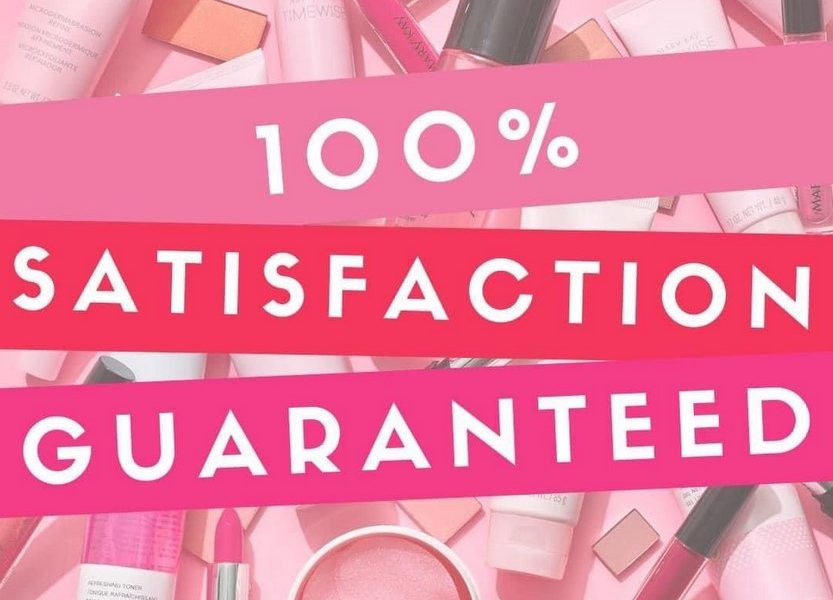
Mary Kay’s 100% Satisfaction Guarantee
 Written by Frosty Rose
Written by Frosty Rose
Mary Kay recruiting pitches always lean in on the fact that the “business opportunity” is so low-risk. “You’re in business for yourself, but not by yourself.” And, “This company has been around for over 60 years. The women who have come before you have written a roadmap for success. They’re here to show you the way.”
The low-risk assertion hangs primarily on two guarantees offered by Mary Kay Inc., out of the goodness of its heart, of course. One is the 90% buy-back guarantee. If you don’t love the business, and it’s not for you, the company will buy back any product you’ve ordered at 90% of your cost. For details on that program and why it’s a joke, check out this article.
The second guarantee the company offers is a 100% satisfaction guarantee to its customers. “And it’s all fully backed by the company. They want our customers to be happy, and they want us to have a profitable business, so they take the hit on any product returns by customers,” your cheery recruiter will parrot.
She won’t, however, share the details on how the company backs its 100% satisfaction guarantee. That’s too many details for your tiny little brain to handle all upfront, after all. So, how does that program work? If you’ve spent any time at all here at Pink Truth, you’ll know that the house (aka Corporate) always wins, and consultants but rarely.
If I, a lowly independent beauty consultant, sell a customer the wrong shade of foundation, she has every right to return it. I’ll encourage her to swap it for another product, and if she does, no harm, no foul. I’ll grab the correct shade from my ample inventory and give it to her, no cash out of my business account. I’ll then let the company know (through a ridiculously arduous process on InTouch) that Mary Lou returned her Ivory 105, and I’d like it replaced with an Ivory 202. “They don’t even charge shipping on those orders! Isn’t the company so generous!!”
But what happens when the customer wants her money back instead of an exchange for a different product? I must honor that request, and write her a check out of my pitifully limited business operating account. I once sold an entire TimeWise Repair set to a woman who had a horrible allergic reaction to it. She wanted a refund. So, I didn’t get a paycheck that week. Of course, I still returned it to corporate, and they still replaced the set. My inventory grew even more, and I had to go find another customer willing to fork out over $200 for substandard skin care.
For an extreme example of what can happen to a consultant, check out this post. Yes, these women (both customers and consultants) are ridiculous. But you have to feel sorry for them, too. On the one hand, the bride and her party were hoodwinked into a “pampering session” and force-fed products they obviously didn’t want. On the other, we’ve exposed time and time again how little money consultants are earning in Mary Kay. To now be on the hook for hundreds of dollars in returns? While Corporate generously sends out even more product to molder on shelves? Neat.
And let’s talk about that return process on the consultants’ end, shall we? Consultants are required to have the product back in their hand to process a return. This is already onerous enough in a digital world with so many sales happening online. Who pays for the return shipping? Not Mary Kay, I can assure you.
Once they have the product, they have to get online and fill out a complicated form, including inane details about the product (day codes, which are never easy to find), and customer details including contact information (most customers don’t want you sharing their phone number with Corporate). After you enter all the information about the product you were returning, you then have to choose which products you wanted to replace them, which had to add up to exactly the same retail amount. Another lengthy search for product codes never used in any other context.
This was easily a 15-minute process per product, and it was a rare month when I didn’t have 5-10 products returned. Oh, and all returns must be processed with the company within 30 days of the transaction with the customer, and consultants must hold the products for a further 30 days in case Corporate wants to recall them. The administrative burden is squarely on the shoulders of the consultant, to guarantee satisfaction with a product over which she has no control.
Obviously, many consultants simply take the hit on their income and don’t return products to the company. Their record-keeping is generally so abysmal that they may not have a full picture of how much they’re losing in this process. I know I didn’t. When I finally threw in the towel on my business, I had close to $300 in product returns that I hadn’t processed with the company. In the end, I fudged the return dates, made up some customers to ascribe them to, and replaced them with products I knew I would personally use.
As with all things in Mary Kay, the 100% satisfaction guarantee is rigged against consultants. The house always wins.





 Visit the
Visit the
If MK consultants were true business owners, they could simply set their own rules, such as “All sales final on discounted merchandise. Return guarantee applies to full price purchases only.” Or, “10% restocking fee on all returns.”
But consultants are not business owners, so they are stuck with Mary Kay rules.
INB4 the huns swoop in on Friday with “but every business has returns that they loose money on!!!!!!!”
The company might lose money, but the salesperson DOES NOT. Legit retailers figure returns and things like theft/ damage/ random wierd stuff into of the cost of doing business as a phenomenon called “shrink”. They’re smart about the price they pay wholesale for their goods and the markups they sell them at so that they can still turn a profit at typical shrink levels.
Since they actually understand the principles of business, their salespeople aren’t made responsible for paying out returns and so get to keep every penny of their pay (and commissions, if applicable).
Don’t forget, you have to be an ACTIVE consultant or you don’t get to exchange that product. Your director loaded you up with a huge initial inventory order when you first signed up (like they all do) & 4 months later someone wants to return something? You either place another $250 wholesale to become active or eat the cost of that returned product.
Also, my director was big into telling us consultants to try ALL the products for ourselves so we could describe the products to customers & told us the satisfaction guarantee applies to us as consultants. It doesn’t. I tried. Clever way of my director to make me use up some inventory, hoping I would then order more. 🤷 It was clever, but unethical.
Clever on two levels. You also opened each item to try it, so you can’t return it.
So I shipped product to my cousin in another state. She doesn’t like it. To return to MK, she has to ship it back to me, and then I ship to MK.
Who’s paying for all that shipping?
Say I buy a miracle set and my consultant quits the next day. Will another consultant be expected to refund my money if that’s how I want to be refunded?
Fake returns. I confess I did that too. I tried so hard to run my “business” not losing money that I engaged in the fake return dilema. I didn’t order unless I absolutely needed to. Inevitably I would run out of a popular item but didn’t have enough sales to warrant an order. Most of the time I just didn’t put a date on the return form until I had enough to justify the shipping cost for getting replacements. Other times I returned old product or unwanted product that I couldn’t get rid of. I chose the unethical route. I don’t like to add a “but,” BUT I wouldn’t have had to do that if MK provided free returns to IBCs.